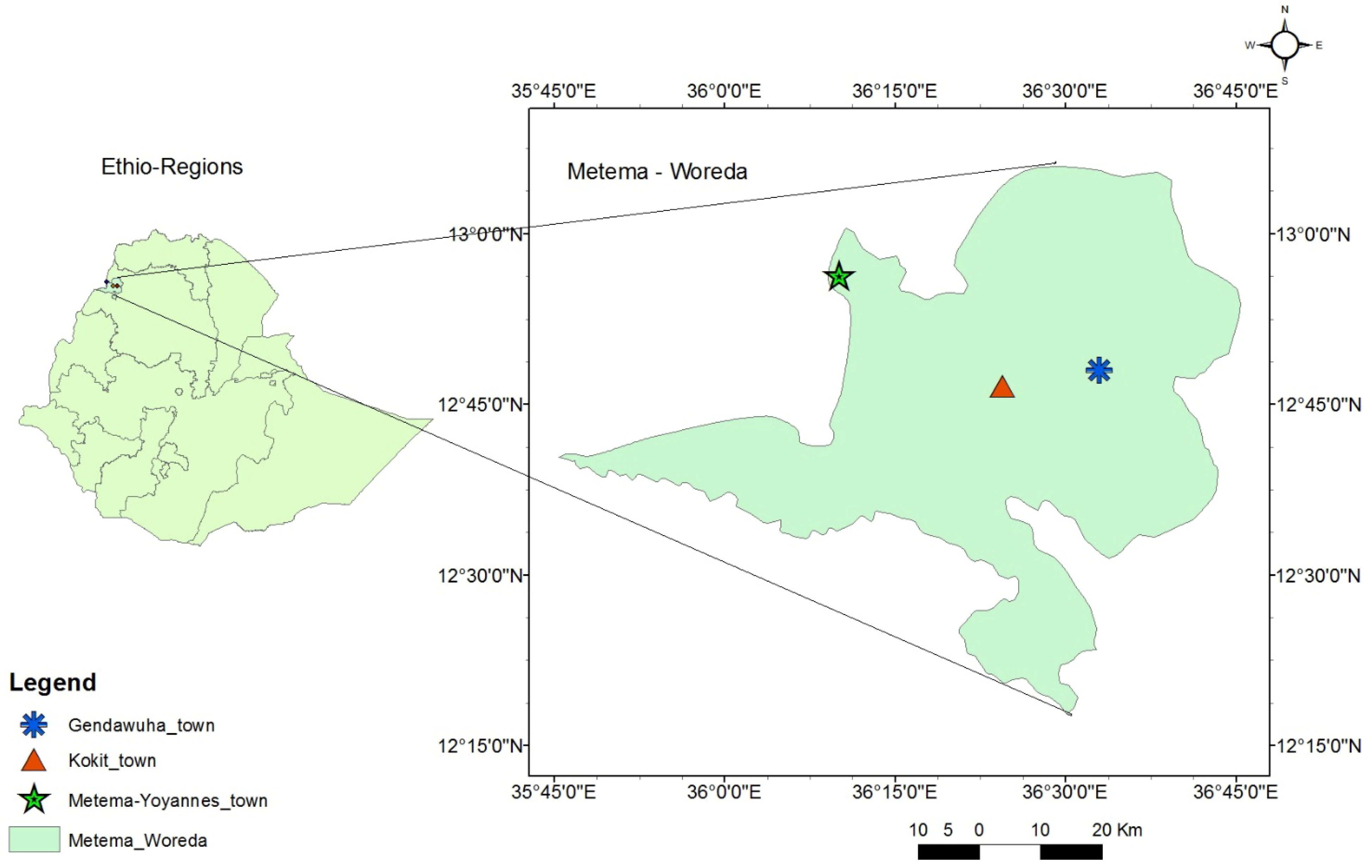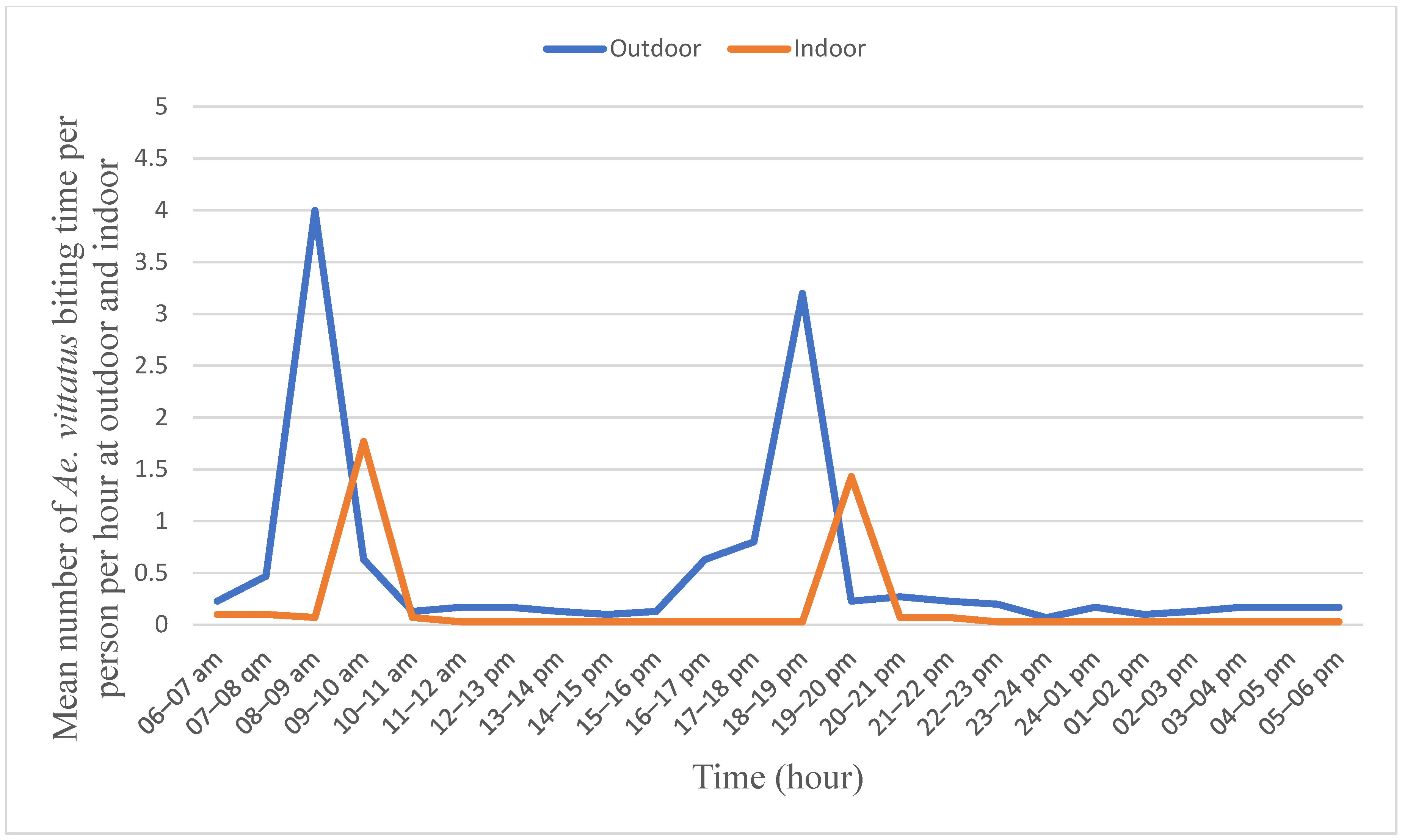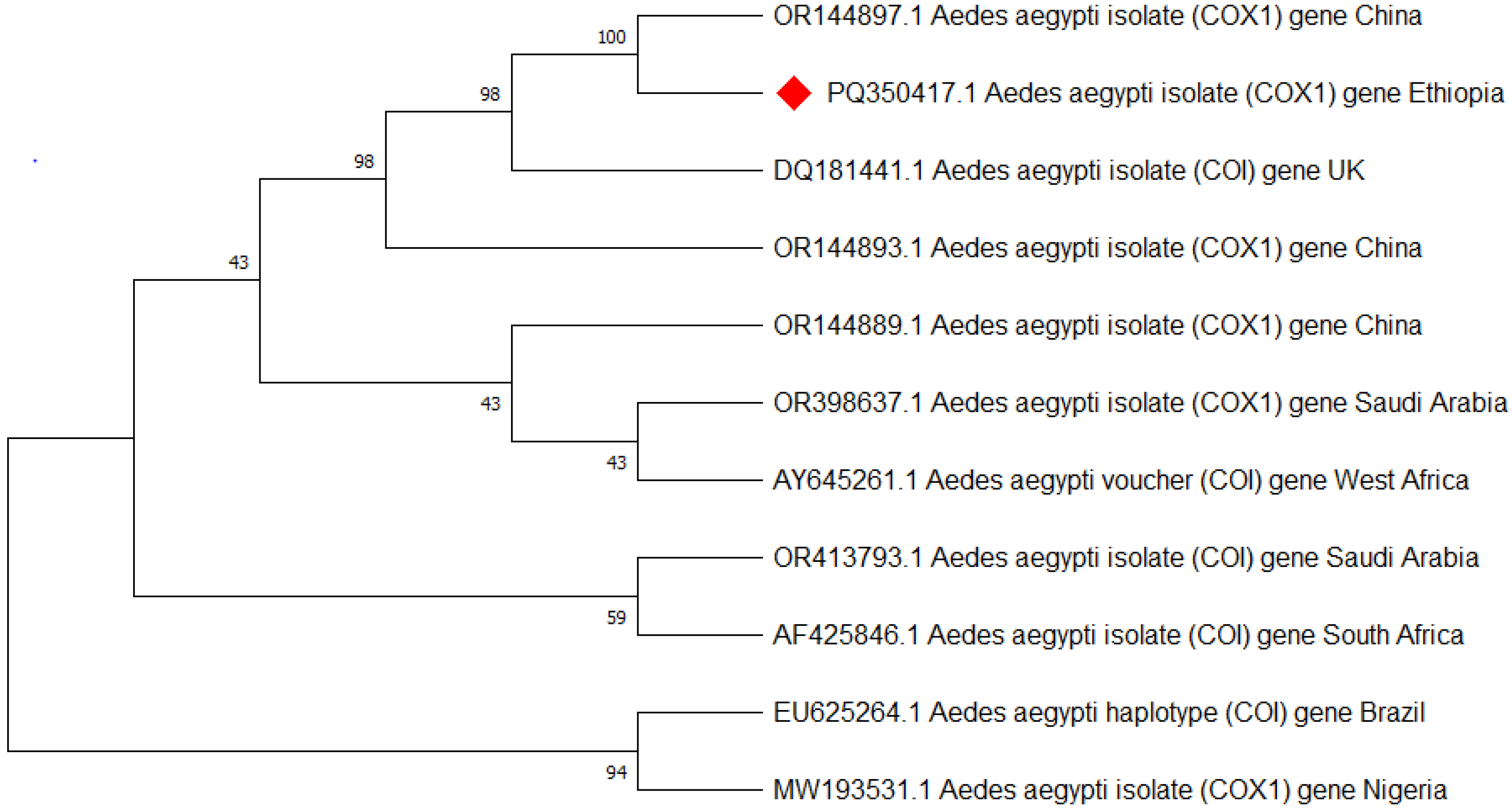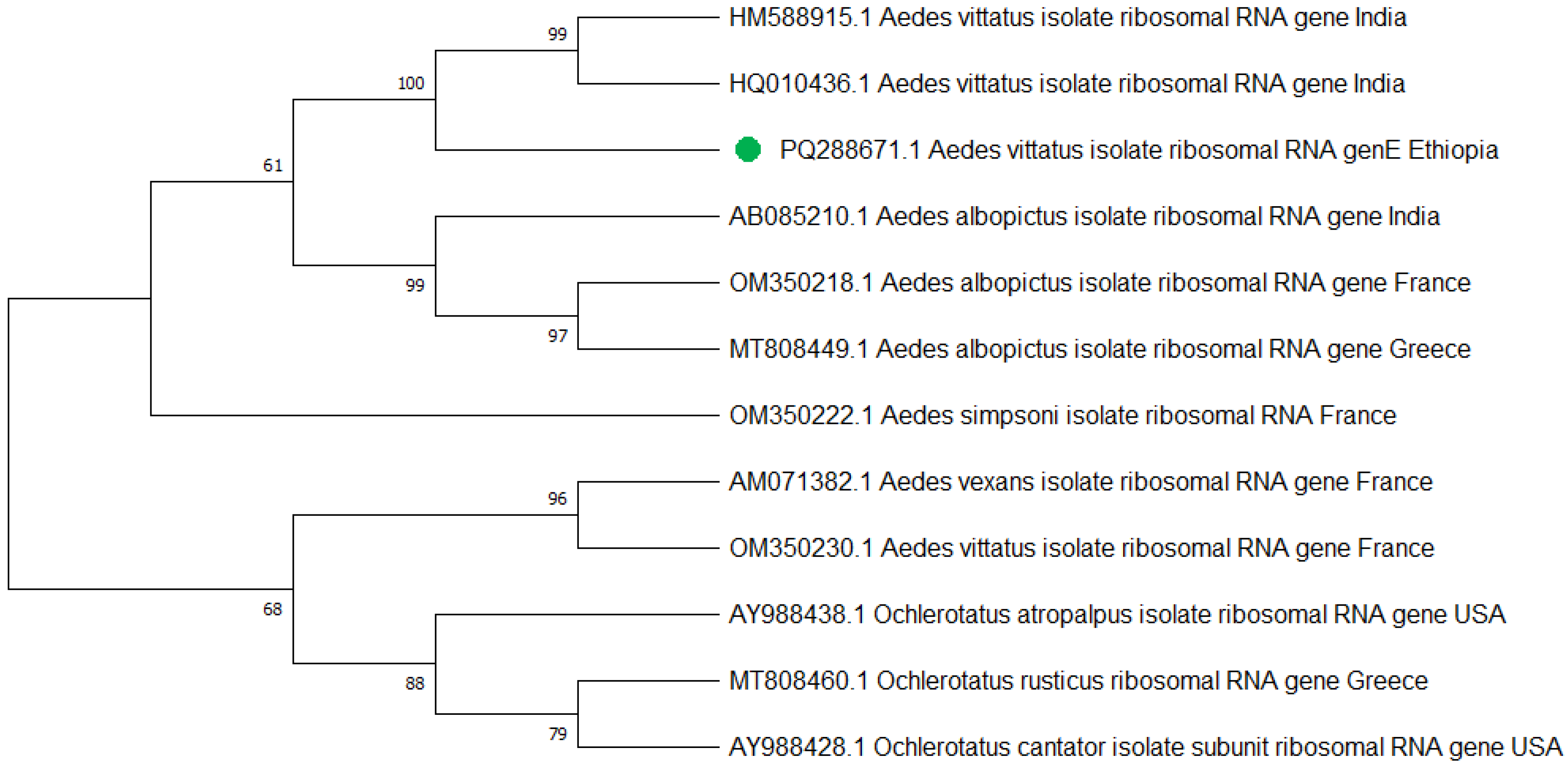Biting Hour and Host Seeking Behavior of Aedes Species in Urban Settings, Metema District, Northwest Ethiopia
Abstract
:1. Introduction
2. Study Setting and Methods
2.1. Study Setting
2.2. Study Design
2.3. Identification of Mosquito Species
2.4. Data Analysis
3. Results
3.1. Composition of Mosquito Species
3.2. Hourly Human Biting Behavior of Aedes aegypti and Aedes vittatus
3.3. Host Seeking Behavior and Physiological Status of Aedes aegypti and Aedes vittatus
3.4. Molecular Identification of Aedes aegypti and Aedes vittatus
4. Discussion
Limitations of the Study
5. Conclusions
Supplementary Materials
Author Contributions
Funding
Institutional Review Board Statement
Informed Consent Statement
Data Availability Statement
Acknowledgments
Conflicts of Interest
Abbreviations
References
- Sudeep, A.; Shil, P. Aedes vittatus (Bigot) mosquito: An emerging threat to public health. J. Vector Borne Dis. 2017, 54, 295–300. [Google Scholar] [CrossRef] [PubMed]
- Agarwal, A.; Parida, M.; Dash, P.K. Impact of transmission cycles and vector competence on global expansion and emergence of arboviruses. Rev. Med. Virol. 2017, 27, e1941. [Google Scholar] [CrossRef] [PubMed]
- Ketkar, H.; Herman, D.; Wang, P. Genetic determinants of the re-emergence of arboviral diseases. Viruses 2019, 11, 150. [Google Scholar] [CrossRef]
- Akinsulie, O.C.; Idris, I. Global Re-emergence of Dengue Fever: The Need for a Rapid Response and Surveillance. Microbe 2024, 4, 100107. [Google Scholar] [CrossRef]
- Kraemer, M.U.; Faria, N.R.; Reiner, R.C.; Golding, N.; Nikolay, B.; Stasse, S.; Johansson, M.A.; Salje, H.; Faye, O.; Wint, G.W. Spread of yellow fever virus outbreak in Angola and the Democratic Republic of the Congo 2015–2016: A modelling study. Lancet Infect. Dis. 2017, 17, 330–338. [Google Scholar] [CrossRef]
- Vasconcelos, P.F.; Bryant, J.E.; Da Rosa, A.P.T.; Tesh, R.B.; Rodrigues, S.G.; Barrett, A.D. Genetic divergence and dispersal of yellow fever virus, Brazil. Emerg. Infect. Dis. 2004, 10, 1578. [Google Scholar] [CrossRef]
- Mutebi, J.-P.; Barrett, A.D. The epidemiology of yellow fever in Africa. Microbes Infect. 2002, 4, 1459–1468. [Google Scholar] [CrossRef]
- Kilpatrick, A.M.; Randolph, S.E. Drivers, dynamics, and control of emerging vector-borne zoonotic diseases. Lancet 2012, 380, 1946–1955. [Google Scholar] [CrossRef]
- Yan, J.; Mackay, A.J.; Stone, C.M. Dynamics of invasive mosquitoes: Introduction pathways, limiting factors, and their potential role in vector-borne pathogen transmission. Front. Trop. Dis. 2024, 5, 1503120. [Google Scholar] [CrossRef]
- Tajudeen, Y.A.; Oladipo, H.J.; Oladunjoye, I.O.; Yusuf, R.O.; Sodiq, H.; Omotosho, A.O.; Adesuyi, D.S.; Yusuff, S.I.; El-Sherbini, M.S. Emerging arboviruses of public health concern in Africa: Priorities for future research and control strategies. Challenges 2022, 13, 60. [Google Scholar] [CrossRef]
- Ahmed, Y.M.; Salah, A.A. Epidemiology of dengue fever in Ethiopian Somali region: Retrospective health facility based study. Cent. Afr. J. Public Health 2016, 2, 51–56. [Google Scholar]
- Degife, L.H.; Worku, Y.; Belay, D.; Bekele, A.; Hailemariam, Z. Factors associated with dengue fever outbreak in Dire Dawa administration city, October, 2015, Ethiopia-case control study. BMC Public Health 2019, 19, 650. [Google Scholar] [CrossRef] [PubMed]
- Geleta, E.N. Serological evidence of dengue fever and its associated factors in health facilities in the Borena Zone, South Ethiopia. Res. Rep. Trop. Med. 2019, 10, 129–136. [Google Scholar] [CrossRef] [PubMed]
- Gould, L.H.; Osman, M.S.; Farnon, E.C.; Griffith, K.S.; Godsey, M.S.; Karch, S.; Mulenda, B.; Kholy, A.E.; Grandesso, F.; de Radiguès, X. An outbreak of yellow fever with concurrent chikungunya virus transmission in South Kordofan, Sudan, 2005. Trans. R. Soc. Trop. Med. Hyg. 2008, 102, 1247–1254. [Google Scholar] [CrossRef]
- Konongoi, S.L.; Nyunja, A.; Ofula, V.; Owaka, S.; Koka, H.; Koskei, E.; Eyase, F.; Langat, D.; Mancuso, J.; Lutomiah, J. Human and entomologic investigations of chikungunya outbreak in Mandera, Northeastern Kenya, 2016. PLoS ONE 2018, 13, e0205058. [Google Scholar] [CrossRef]
- Mengesha Tsegaye, M.; Tayachew, A.; Belay, D.; Alemu, A.; Beyene, B. A35 The first laboratory confirmation of chikungunya outbreak in Ethiopia. Virus Evol. 2019, 5, vez002.034. [Google Scholar] [CrossRef]
- Endale, A.; Michlmayr, D.; Abegaz, W.E.; Asebe, G.; Larrick, J.W.; Medhin, G.; Legesse, M. Community-based sero-prevalence of chikungunya and yellow fever in the South Omo Valley of Southern Ethiopia. PLoS Neglected Trop. Dis. 2020, 14, e0008549. [Google Scholar] [CrossRef]
- Andral, L.; Poirier, A.; Lindrec, A.; Neri, P. Studies on yellow fever in Ethiopia. 6. Epidemiologic study. Bull. World Health Organ. 1968, 38, 879–884. [Google Scholar]
- Mulchandani, R.; Massebo, F.; Bocho, F.; Jeffries, C.L.; Walker, T.; Messenger, L.A. A community-level investigation following a yellow fever virus outbreak in South Omo Zone, South-West Ethiopia. PeerJ 2019, 7, e6466. [Google Scholar] [CrossRef]
- Nigatu, W.; Asrat, Y.; Sisay, C.; Gunta, M.; Belay, D.; Tasew, G.; Waldetensai, A. Aedes Mosquitoes distribution and risk of Yellow Fever transmission in Gurage Zone, Southwest Ethiopia. Ethiop. J. Public Health Nutr. 2020, 4, 21–31. [Google Scholar]
- Elamin, Y.E.; Bashir, N.H.; Elhaj, H.F.; Allah, E.A.A.H.; Khogali, A.; Alzahrani, M.H.; Hassan, M.A.M. Mosquito fauna and the first record of Aedes vittatus (Diptera: Culicidae) in Kassala State, eastern Sudan. Int. J. Mosq. Res. 2023, 10, 28–34. [Google Scholar] [CrossRef]
- Hamid, H.; Musa, H.; Ahmed, A.; Azeez, T.A.; Adam, A.; Malik, M.A.; El Tahir, A.; Kafy, H.; Azrag, R. Stegomyia indices of Aedes aquatic stages in El Geneina town, western Sudan. East. Mediterr. Health J. 2021, 27, 1189–1196. [Google Scholar] [CrossRef] [PubMed]
- Delatte, H.; Desvars, A.; Bouétard, A.; Bord, S.; Gimonneau, G.; Vourc’h, G.; Fontenille, D. Blood-feeding behavior of Aedes albopictus, a vector of Chikungunya on La Réunion. Vector-Borne Zoonotic Dis. 2010, 10, 249–258. [Google Scholar] [CrossRef]
- Getachew Ferede, G.F.; Moges Tiruneh, M.T.; Ebba Abate, E.A.; Kassa, W.J.; Yitayih Wondimeneh, Y.W.; Demekech Damtie, D.D.; Belay Tessema, B.T. Distribution and larval breeding habitats of Aedes mosquito species in residential areas of northwest Ethiopia. Epidemiol. Health 2018, 40, e2018015. [Google Scholar] [CrossRef]
- Sarma, D.K.; Kumar, M.; Dhurve, J.; Pal, N.; Sharma, P.; James, M.M.; Das, D.; Mishra, S.; Shubham, S.; Kumawat, M. Influence of host blood meal source on gut microbiota of wild caught Aedes aegypti, a dominant arboviral disease vector. Microorganisms 2022, 10, 332. [Google Scholar] [CrossRef]
- Baik, L.S.; Nave, C.; Au, D.D.; Guda, T.; Chevez, J.A.; Ray, A.; Holmes, T.C. Circadian regulation of light-evoked attraction and avoidance behaviors in daytime-versus nighttime-biting mosquitoes. Curr. Biol. 2020, 30, 3252–3259.e3253. [Google Scholar] [CrossRef]
- Tedjou, A.N.; Kamgang, B.; Yougang, A.P.; Wilson-Bahun, T.A.; Njiokou, F.; Wondji, C.S. Patterns of ecological adaptation of Aedes aegypti and Aedes albopictus and Stegomyia indices highlight the potential risk of arbovirus transmission in Yaoundé, the Capital City of Cameroon. Pathogens 2020, 9, 491. [Google Scholar] [CrossRef]
- Scott, T.W.; Amerasinghe, P.H.; Morrison, A.C.; Lorenz, L.H.; Clark, G.G.; Strickman, D.; Kittayapong, P.; Edman, J.D. Longitudinal studies of Aedes aegypti (Diptera: Culicidae) in Thailand and Puerto Rico: Blood feeding frequency. J. Med. Entomol. 2000, 37, 89–101. [Google Scholar] [CrossRef]
- Zahid, M.H.; Van Wyk, H.; Morrison, A.C.; Coloma, J.; Lee, G.O.; Cevallos, V.; Ponce, P.; Eisenberg, J.N. The biting rate of Aedes aegypti and its variability: A systematic review (1970–2022). PLoS Neglected Trop. Dis. 2023, 17, e0010831. [Google Scholar] [CrossRef]
- Mondal, R.; Devi, N.P.; Bhattacharya, S. Seasonal Prevalence and Host Preference of Some Medically Important Aedes Species of Doon Valley, India. J. Commun. Dis. 2021, 53, 96–103. [Google Scholar] [CrossRef]
- Ferede, G.; Tiruneh, M.; Abate, E.; Wondimeneh, Y.; Gadisa, E.; Howe, R.; Aseffa, A.; Tessema, B. Evidence of chikungunya virus infection among febrile patients in northwest Ethiopia. Int. J. Infect. Dis. 2021, 104, 183–188. [Google Scholar] [CrossRef] [PubMed]
- Ferede, G.; Tiruneh, M.; Abate, E.; Wondimeneh, Y.; Damtie, D.; Gadisa, E.; Howe, R.; Aseffa, A.; Tessema, B. A serologic study of dengue in northwest Ethiopia: Suggesting preventive and control measures. PLoS Neglected Trop. Dis. 2018, 12, e0006430. [Google Scholar] [CrossRef] [PubMed]
- Kendie, F.A.; Mekuriaw, S.A.; Dagnew, M.A. Ethnozoological study of traditional medicinal appreciation of animals and their products among the indigenous people of Metema Woreda, North-Western Ethiopia. J. Ethnobiol. Ethnomedicine 2018, 14, 37. [Google Scholar] [CrossRef] [PubMed]
- Bower, H.; El Karsany, M.; Adam, A.A.A.H.; Idriss, M.I.; Alzain, M.a.A.; Alfakiyousif, M.E.A.; Mohamed, R.; Mahmoud, I.; Albadri, O.; Mahmoud, S.A.A. “Kankasha” in Kassala: A prospective observational cohort study of the clinical characteristics, epidemiology, genetic origin, and chronic impact of the 2018 epidemic of Chikungunya virus infection in Kassala, Sudan. PLoS Neglected Trop. Dis. 2021, 15, e0009387. [Google Scholar] [CrossRef]
- Schaffner, F.; Angel, G.; Geoffroy, B.; Hervy, J.-P.; Rhaiem, A.; Brunhes, J. Les Moustiques d’Europe: Logiciel D’identification et D’enseignement = The Mosquitoes of Europe: An Identification and Training Programme; IRD Editions & EID Méditerranée: Montpellier, France, 2001. [Google Scholar]
- Romero-Weaver, A.L.; Riles, M.T.; Sloyer, K.; Lee, Y.; Campbell, L.P.; Giordano, B.V. A concise guide on the bionomics and key morphological characteristics for identifying Aedes pertinax (Grabham, 1906)—A mosquito species from neotropics: ENY2100/IN1405, 6/2023. EDIS 2023, 2023, 3. [Google Scholar] [CrossRef]
- Singh, D.; Kaur, R. Comparison of three different methods for DNA extraction from bugs of family Pentatomidae (Hemiptera) for PCR. J. Entomol. Zool. Stud. 2017, 5, 57–61. [Google Scholar]
- Das, M.; Das, M.K.; Dutta, P. Genetic characterization and molecular phylogeny of Aedes albopictus (Skuse) species from Sonitpur district of Assam, India based on COI and ITS1 genes. J. Vector Borne Dis. 2016, 53, 240–247. [Google Scholar]
- Altschul, S.F.; Gish, W.; Miller, W.; Myers, E.W.; Lipman, D.J. Basic local alignment search tool. J. Mol. Biol. 1990, 215, 403–410. [Google Scholar] [CrossRef]
- Saitou, N.; Nei, M. The neighbor-joining method: A new method for reconstructing phylogenetic trees. Mol. Biol. Evol. 1987, 4, 406–425. [Google Scholar]
- Felsenstein, J. Confidence limits on phylogenies: An approach using the bootstrap. Evolution 1985, 39, 783–791. [Google Scholar] [CrossRef]
- Tamura, K.; Kumar, S. Evolutionary distance estimation under heterogeneous substitution pattern among lineages. Mol. Biol. Evol. 2002, 19, 1727–1736. [Google Scholar] [CrossRef] [PubMed]
- Tamura, K.; Stecher, G.; Kumar, S. MEGA11: Molecular evolutionary genetics analysis version 11. Mol. Biol. Evol. 2021, 38, 3022–3027. [Google Scholar] [CrossRef] [PubMed]
- Odero, J.I.; Abong’o, B.; Moshi, V.; Ekodir, S.; Harvey, S.A.; Ochomo, E.; Gimnig, J.E.; Achee, N.L.; Grieco, J.P.; Oria, P.A. Early morning anopheline mosquito biting, a potential driver of malaria transmission in Busia County, western Kenya. Malar. J. 2024, 23, 66. [Google Scholar] [CrossRef]
- Van Dung, N.; Thieu, N.Q.; Canh, H.D.; Le Duy, B.; Hung, V.V.; Ngoc, N.T.H.; Mai, N.V.T.; Van Anh, N.T.; Son, L.D.; Oo, W.H. Anopheles diversity, biting behaviour and transmission potential in forest and farm environments of Gia Lai province, Vietnam. Malar. J. 2023, 22, 204. [Google Scholar] [CrossRef]
- Rani, E.; Surendran, A.; Thatheyus, A. Biting Behaviour of The Filarial Vector Mosquito, Culex quinquefasciatusSay, in an Urban Area. J. Plant Anim. Ecol. 2020, 2, 1–13. [Google Scholar] [CrossRef]
- Vythilingam, I.; Oda, K.; Chew, T.; Mahadevan, S.; Vijayamalar, B.; Morita, K.; Tsuchie, H.; Igarashi, A. Isolation of Japanese encephalitis virus from mosquitoes collected in Sabak Bernam, Selangor, Malaysia in 1992. J. Am. Mosq. Control Assoc. 1995, 11, 94–98. [Google Scholar]
- Chompoosri, J.; Thavara, U.; Tawatsin, A.; Anantapreecha, S.; Siriyasatien, P. Seasonal monitoring of dengue infection in Aedes aegypti and serological feature of patients with suspected dengue in 4 central provinces of Thailand. Thai J. Vet. Med. 2012, 42, 185–193. [Google Scholar] [CrossRef]
- Chadee, D.D.; Martinez, R. Landing periodicity of Aedes aegypti with implications for dengue transmission in Trinidad, West Indies. J. Vector Ecol. J. Soc. Vector Ecol. 2000, 25, 158–163. [Google Scholar]
- Captain-Esoah, M.; Kweku Baidoo, P.; Frempong, K.K.; Adabie-Gomez, D.; Chabi, J.; Obuobi, D.; Kwame Amlalo, G.; Balungnaa Veriegh, F.; Donkor, M.; Asoala, V. Biting behavior and molecular identification of Aedes aegypti (Diptera: Culicidae) subspecies in some selected recent yellow fever outbreak communities in Northern Ghana. J. Med. Entomol. 2020, 57, 1239–1245. [Google Scholar] [CrossRef]
- Paramasivan, R.; Philip, S.; Selvaraj, P. Biting rhythm of vector mosquitoes in a rural ecosystem of South India. Int J Mosq Res 2015, 2, 106–113. [Google Scholar]
- Githeko, A.K.; Lindsay, S.W.; Confalonieri, U.E.; Patz, J.A. Climate change and vector-borne diseases: A regional analysis. Bull. World Health Organ. 2000, 78, 1136–1147. [Google Scholar] [PubMed]
- Rund, S.S.; Labb, L.F.; Benefiel, O.M.; Duffield, G.E. Artificial light at night increases Aedes aegypti mosquito biting behavior with implications for arboviral disease transmission. Am. J. Trop. Med. Hyg. 2020, 103, 2450. [Google Scholar] [CrossRef] [PubMed]
- Mengesha Tsegaye, M.; Beyene, B.; Ayele, W.; Abebe, A.; Tareke, I.; Sall, A.; Yactayo, S.; Shibeshi, M.E.; Staples, E.; Belay, D. Sero-prevalence of yellow fever and related Flavi viruses in Ethiopia: A public health perspective. BMC Public Health 2018, 18, 1011. [Google Scholar] [CrossRef]
- World Health Organization. Prevention and Control of Yellow Fever in Africa; World Health Organization: Geneva, Switzerland, 1986. [Google Scholar]
- World Health Organization. Technical guide for a system of yellow fever surveillance. Wkly. Epidemiol. Rec. = Relev. Épidémiologique Hebd. 1971, 46, 493–500. [Google Scholar]
- Cebrián-Camisón, S.; Martínez-de la Puente, J.; Figuerola, J. A literature review of host feeding patterns of invasive Aedes mosquitoes in Europe. Insects 2020, 11, 848. [Google Scholar] [CrossRef]
- Kramer, L.D.; Ciota, A.T. Dissecting vectorial capacity for mosquito-borne viruses. Curr. Opin. Virol. 2015, 15, 112–118. [Google Scholar] [CrossRef]
- Wilson, J.J.; Sevarkodiyone, S. Host preference of blood feeding mosquitoes in rural areas of southern Tamil Nadu, India. Acad. J. Entomol. 2015, 8, 80–83. [Google Scholar]
- De Santos, E.M.M.; de Melo-Santos, M.A.V.; de Oliveira, C.M.F.; Correia, J.C.; de Albuquerque, C.M.R. Evaluation of a sticky trap (AedesTraP), made from disposable plastic bottles, as a monitoring tool for Aedes aegypti populations. Parasites Vectors 2012, 5, 195. [Google Scholar] [CrossRef]






| Study Town | Species | Day Light Time | Day Night Time | |||
|---|---|---|---|---|---|---|
| (6:00–18:00) | (18:00–6:00) | |||||
| Indoor | Outdoor | Indoor | Outdoor | Total | ||
| Metema-Yohannes | Aedes aegypti | 309 | 839 | 295 | 561 | 2004 |
| Aedes vittatus | 147 | 380 | 133 | 184 | 844 | |
| Aedes albopictus | 17 | 19 | 0 | 12 | 48 | |
| Aedes communis | 0 | 0 | 0 | 0 | 0 | |
| Aedes opok | 13 | 9 | 0 | 6 | 28 | |
| Anopheles gambiae s.l. | 0 | 0 | 76 | 123 | 199 | |
| Anopheles stephensi | 0 | 0 | 37 | 65 | 102 | |
| Anopheles pretoriensis | 0 | 0 | 11 | 23 | 34 | |
| Anopheles christyi | 0 | 0 | 5 | 7 | 12 | |
| Anopheles cinereus | 0 | 0 | 3 | 6 | 9 | |
| Culiseta longiareolata | 0 | 0 | 0 | 0 | 0 | |
| Culex spp. | 0 | 0 | 1220 | 2415 | 3635 | |
| Total | 486 | 1247 | 1780 | 3402 | 6915 | |
| Kokit | Aedes aegypti | 163 | 494 | 107 | 396 | 1160 |
| Aedes vittatus | 87 | 242 | 67 | 172 | 568 | |
| Aedes albopictus | 0 | 0 | 0 | 0 | 0 | |
| Aedes communis | 17 | 29 | 0 | 19 | 65 | |
| Aedes opok | 0 | 0 | 0 | 0 | 0 | |
| Anopheles gambiae s.l. | 0 | 0 | 42 | 107 | 149 | |
| Anopheles Stephensi | 0 | 0 | 15 | 26 | 41 | |
| Anopheles Pretoriensis | 0 | 0 | 3 | 7 | 10 | |
| Anopheles christyi | 0 | 0 | 0 | 5 | 5 | |
| Anopheles Cinereus | 0 | 0 | 0 | 3 | 3 | |
| Culiseta Longiareolata | 0 | 0 | 0 | 25 | 25 | |
| Culex spp. | 0 | 0 | 768 | 1152 | 1920 | |
| Total | 267 | 765 | 1002 | 1912 | 3946 | |
| Aedes aegypti | 193 | 519 | 87 | 370 | 1169 | |
| Aedes vittatus | 87 | 256 | 28 | 112 | 483 | |
| Aedes albopictus | 0 | 0 | 0 | 0 | 0 | |
| Aedes communis | 0 | 12 | 13 | 17 | 42 | |
| Genda-Wuha | Aedes opok | 0 | 0 | 0 | 0 | 0 |
| Anopheles gambiae s.l. | 0 | 0 | 53 | 81 | 134 | |
| Anopheles Stephensi | 0 | 0 | 17 | 47 | 64 | |
| Anopheles Pretoriensis | 0 | 0 | 10 | 16 | 26 | |
| Anopheles, chrisityi | 0 | 0 | 0 | 7 | 7 | |
| Anopheles Cinereus | 0 | 0 | 0 | 5 | 5 | |
| Culiseta Longiareolata | 0 | 0 | 0 | 32 | 32 | |
| Culex spp. | 0 | 0 | 1341 | 2160 | 3501 | |
| Total | 280 | 787 | 1549 | 2847 | 5463 | |
| Ae. aegypti | Ae. vittatus | |||||||
|---|---|---|---|---|---|---|---|---|
| Unfed n (%) | Blood Fed n (%) | Gravid n (%) | Total N | Unfed n (%) | Blood Fed n (%) | Gravid n (%) | Total N | |
| Human | 3318 (81.8) | 232 (86.2) | 90 (80.4) | 3640 (82.1) | 1329 (74.5) | 118 (79.2) | 24 (55.8) | 1471 (74.5) |
| Cattel | 276 (6.9) | 18 (6.7) | 6 (5.3) | 300 (6.7) | 197 (11.6) | 14 (9.4) | 4 (9.3) | 215 (10.9) |
| sheep | 194 (4.9) | 7 (2.6) | 4 (3.6) | 205 (4.6) | 104 (6.1) | 7 (4.7) | 7 (16.3) | 118 (6.0) |
| Goat | 153 (3.9) | 8 (2.9) | 7 (6.2) | 168 (3.8) | 82 (4.8) | 6 (4.0) | 4 (9.3) | 92 (4.7) |
| Donkey | 114 (2.9) | 4 (1.5) | 5 (4.5) | 123 (2.7) | 71 (4.2) | 4 (2.7) | 4 (3.3) | 79 (4.0) |
| Total | 4055 (91.4) | 269 (6.1) | 112 (2.5) | 4436 | 1783 (90.3) | 149 (7.5) | 43(2.2) | 1975 |
Disclaimer/Publisher’s Note: The statements, opinions and data contained in all publications are solely those of the individual author(s) and contributor(s) and not of MDPI and/or the editor(s). MDPI and/or the editor(s) disclaim responsibility for any injury to people or property resulting from any ideas, methods, instructions or products referred to in the content. |
© 2025 by the authors. Licensee MDPI, Basel, Switzerland. This article is an open access article distributed under the terms and conditions of the Creative Commons Attribution (CC BY) license (https://creativecommons.org/licenses/by/4.0/).
Share and Cite
Jemberie, W.; Dugassa, S.; Animut, A. Biting Hour and Host Seeking Behavior of Aedes Species in Urban Settings, Metema District, Northwest Ethiopia. Trop. Med. Infect. Dis. 2025, 10, 38. https://doi.org/10.3390/tropicalmed10020038
Jemberie W, Dugassa S, Animut A. Biting Hour and Host Seeking Behavior of Aedes Species in Urban Settings, Metema District, Northwest Ethiopia. Tropical Medicine and Infectious Disease. 2025; 10(2):38. https://doi.org/10.3390/tropicalmed10020038
Chicago/Turabian StyleJemberie, Wondmeneh, Sisay Dugassa, and Abebe Animut. 2025. "Biting Hour and Host Seeking Behavior of Aedes Species in Urban Settings, Metema District, Northwest Ethiopia" Tropical Medicine and Infectious Disease 10, no. 2: 38. https://doi.org/10.3390/tropicalmed10020038
APA StyleJemberie, W., Dugassa, S., & Animut, A. (2025). Biting Hour and Host Seeking Behavior of Aedes Species in Urban Settings, Metema District, Northwest Ethiopia. Tropical Medicine and Infectious Disease, 10(2), 38. https://doi.org/10.3390/tropicalmed10020038







